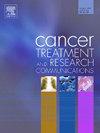EGFR外显子20插入突变的晚期NSCLC患者在铂基化疗后使用阿米万他单抗或莫博西替尼治疗的现实世界治疗模式:一项多数据库队列研究
IF 2.4
Q3 Medicine
引用次数: 0
摘要
目的描述EGFR外显子20插入(exon20ins)阳性的晚期或转移性非小细胞肺癌(NSCLC)患者在铂基化疗(PBC)后接受阿米伐他单抗或莫博西替尼单药治疗的特征、治疗模式和结果。患者和方法本回顾性纵向队列研究汇集了来自Flatiron health(2011年1月- 2022年8月)、安大达(2013年1月- 2023年1月)和COTA(2010年1月- 2022年12月)数据库的电子健康记录。晚期或转移性EGFR外显子20ins NSCLC患者(≥20岁)在PBC后接受阿米万他单抗或莫博西替尼治疗。对患者特征和治疗模式进行描述性分析。采用Kaplan-Meier估计法评估下一次治疗或死亡时间(TTNTD)和停药时间(TTD)。结果44例阿米伐他抗组和24例莫博昔替尼组符合入选标准。患者特征与既往研究一致。大多数患者接受amivantamab或mobocertinib作为二线(57%和50%)或三线(32%和33%)治疗。amivantamab的中位ttnd为9.2个月,mobocertinib为4.2个月。amivantamab组(43%)发生TTNTD事件的患者少于mobocertinib组(63%)。amivantamab组的中位TTD为8.6个月,mobocertinib组为2.3个月,amivantamab组的停药率较低(46%对67%)。结论:在PBC后接受amivantamab治疗的EGFR外显子20蛋白NSCLC患者的中位TTNTD和TTD与注册试验中观察到的中位无进展生存期一致,而接受mobocertinib治疗的患者表现出更快的疾病进展和更高的停药频率。这项回顾性研究描述了EGFR外显子20in突变的晚期或转移性NSCLC患者在铂基化疗后接受阿米万他单抗或莫博西替尼单药治疗的患者特征、治疗模式和结果。在现实世界中,接受阿米伐他单治疗的患者经历了TTNTD和TTD,这与注册试验中观察到的中位无进展生存期一致,而接受莫博西替尼治疗的患者表现出更快的疾病进展和更高的停药频率。本文章由计算机程序翻译,如有差异,请以英文原文为准。
Real-world treatment patterns of patients with EGFR exon 20 insertion–mutated advanced NSCLC treated with amivantamab or mobocertinib after platinum-based chemotherapy: A multi-database cohort study
Objective
To describe characteristics, treatment patterns, and outcomes of patients with EGFR exon 20 insertion (exon20ins)-positive advanced or metastatic non–small cell lung cancer (NSCLC) who received amivantamab or mobocertinib monotherapy after platinum-based chemotherapy (PBC).
Patients and Methods
This retrospective longitudinal cohort study pooled electronic health records from the Flatiron Health (January 2011-August 2022), Ontada (January 2013-January 2023), and COTA (January 2010-December 2022) databases. Patients (≥20 years) with advanced or metastatic EGFR exon20ins NSCLC who received amivantamab or mobocertinib following PBC were included. Patient characteristics and treatment patterns were analyzed descriptively. Time to next treatment or death (TTNTD) and time to discontinuation (TTD) were assessed using Kaplan-Meier estimates.
Results
44 patients treated with amivantamab and 24 patients with mobocertinib after PBC met the selection criteria. Patient characteristics were consistent with previous studies. Most patients received amivantamab or mobocertinib as second-line (57 % and 50 %) or third-line (32 % and 33 %) therapy. The median TTNTD was 9.2 months for amivantamab and 4.2 months for mobocertinib. Fewer patients in the amivantamab cohort (43 %) experienced a TTNTD event than the mobocertinib cohort (63 %). The median TTD was 8.6 months for amivantamab and 2.3 months for mobocertinib, with a lower discontinuation rate in the amivantamab cohort (46 % vs 67 %).
Conclusion
Real-world patients with EGFR exon20ins NSCLC treated with amivantamab after PBC experienced median TTNTD and TTD consistent with the median progression-free survival observed in its registrational trial while patients treated with mobocertinib exhibited faster disease progression and a higher frequency of treatment discontinuation.
MicroAbstract
This retrospective study described patient characteristics, treatment patterns, and outcomes in patients with EGFR exon20ins-mutated advanced or metastatic NSCLC who received amivantamab or mobocertinib monotherapy after platinum-based chemotherapy. Real-world patients treated with amivantamab experienced TTNTD and TTD consistent with the median progression-free survival observed in its registrational trial, while patients treated with mobocertinib exhibited faster disease progression and a higher frequency of treatment discontinuation.
求助全文
通过发布文献求助,成功后即可免费获取论文全文。
去求助
来源期刊

Cancer treatment and research communications
Medicine-Oncology
CiteScore
4.30
自引率
0.00%
发文量
148
审稿时长
56 days
期刊介绍:
Cancer Treatment and Research Communications is an international peer-reviewed publication dedicated to providing comprehensive basic, translational, and clinical oncology research. The journal is devoted to articles on detection, diagnosis, prevention, policy, and treatment of cancer and provides a global forum for the nurturing and development of future generations of oncology scientists. Cancer Treatment and Research Communications publishes comprehensive reviews and original studies describing various aspects of basic through clinical research of all tumor types. The journal also accepts clinical studies in oncology, with an emphasis on prospective early phase clinical trials. Specific areas of interest include basic, translational, and clinical research and mechanistic approaches; cancer biology; molecular carcinogenesis; genetics and genomics; stem cell and developmental biology; immunology; molecular and cellular oncology; systems biology; drug sensitivity and resistance; gene and antisense therapy; pathology, markers, and prognostic indicators; chemoprevention strategies; multimodality therapy; cancer policy; and integration of various approaches. Our mission is to be the premier source of relevant information through promoting excellence in research and facilitating the timely translation of that science to health care and clinical practice.
 求助内容:
求助内容: 应助结果提醒方式:
应助结果提醒方式:


